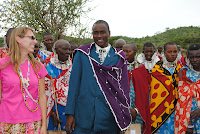

Many people have asked what it means when we say we went to the bush. Yesterday, I went 'to the bush' so I will attempt to share with you what that means.
First of all, to get to even the nearest village where we work, Mairowa, you must leave at sunrise. We don't travel in the dark here as the roads are terrible, too many animals, no streetlights, and other interesting hazards. So off you go, bouncing down the road in the LandCruiser. The road is so bumpy and full of holes big enough to swallow small cars, that the driver has to keep both hands on the wheel and passengers have to hold on to something to not go flying across the seat! We joke that we like to travel with the vehicle full so we don't fly around very much.
Usually our first stop is at Joseph's house. He is a Maasai man with an incredible heart for people. He works for our CMF team as the CHE project leader/church planter support in the region known as Engarenaibor. When we arrive, his wife is ready to serve you a steaming hot cup of chai. The tin cup is so hot to hold, but you must down the drink as to not offend their hospitality. That is so important in their culture. The tea is very light as it is mixed with goat's milk. As I don't love the stuff, I politely drink about half the cup, then quietly hand it off to Joseph's 5 year old daughter, Nempris, who loves chai!
After chai and enough 'greetings' (another must in the culture) you can go off to begin your tasks of the day. Everytime is different, sometimes continuing on another hour or two to another village or staying in the area. Yesterday, all of our work was within 8 kilometers of Joseph's house. While many times I travel to the bush alone, this time our team consisted of myself, Ron and Wendy (CMF missionaries) and Amy and Sarah (CMF interns). We proceeded to the Oliserian church to drop off Wendy and Amy. This church has a preschool that meets daily and Wendy had research to do as she is attempting to train teachers in the area. We got out for a bit to see their new cookhouse, which is basically sticks tied together. The cookhouse provides a place for a daily meal to be cooked for the children, thanks to IDES. We say our goodbyes to Wendy and Amy and are off to our next stop...
The CHE Project Land is where the new Widow & Orphan Project is centered. Ron needed to check on the progress of the construction and also deliver and set up the new water tank! It is wonderful to now have water on site, thanks to a donor Wendy secured while in the States.
While Ron was busy setting brick, etc. (with the ever present Maasai audience) Sarah and I found a spot to interview more children for the Orphan Sponosorship Program. We found a pile of stones to sit on, checking for snakes first. The minister of the Ngoswak church and two village elders sat with me as I spoke with the children, through Joseph's translation. At this point, as our formal language learning has been Swahili, I only know common greetings and phrases in the Maa language. *I'll have a separate post describing the orphan interviews.
As it was almost two in the afternoon, we remembered that we were supposed to go back and get Wendy and Amy! But, of course, before we could leave, another cup of chai. As we headed back up to Oliserian, we saw Wendy and Amy walking down the dirt road toward us in the much needed rain!
Back at Joseph's house, we were served lunch before starting our journey back to Arusha. As always, you start the trip no later than 4:00 to get back before nightfall. Our lunch consisted of a plate of steaming hot rice and mystery meat. As always, you dig in with your fingers!
After saying goodbyes, the long ride home begins. Other than calling out animal sightings, everyone is always pretty quiet on the way home as we are so tired, dirty and sunburnt. Also, because you have a lot to process, news of a child's death from measles, seeing many needs, but most of all, seeing all the ways that God is at work.
Thanks for joining me for a day in the bush!


























